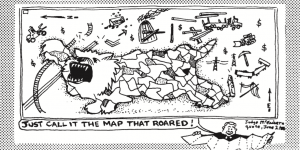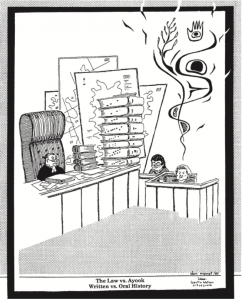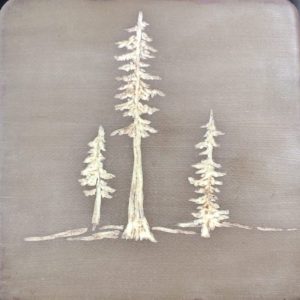For this week’s post, I will be responding to the following prompt:
“[I]n her essay, Maracle answers her question describing what she sees to be the function of literary criticism in Salish society. Summarize her answer and then make some comparisons between Maracle and Frye’s analysis of the role of myth in nation building” (Paterson, question 6).
In order for criticism to arise naturally from within our culture, discourse must serve the same function it has always served. In Euro-society, literary criticism heightens the competition between writers and limits entry of new writers to preserve the original canon. What will its function be in our societies? (Maracle 85)
Author, storyteller, and educator Lee Maracle poses this question in her essay, “Toward a National Literature,” where she continues to explore different elements of what the function of criticism could be, especially with regards to First Nation society (Maracle identifies herself as Sto:lo). In her “response,” Maracle suggests that story and its criticism can be a prompt for discourse and “healthy communal doubt” (85). This questioning can create inspiration to reflect on one’s self and society, or “face ourselves,” and to grow and transform by expanding clan knowledge or augmenting “the house … by adding rafters” (Maracle 85). Once augmented, it calls for new myths to be created based on these changes, which can help to spark opportunities for group learning and further criticism and reflection on the story’s role and relationship to oneself and one’s community, and to their continued growth. In the words of Maracle, the “purpose for examining old story is first to understand it; second, to see oneself in the story; and then to see the nation, the community, and our common humanity through the story and to assess its value to continued growth and transformation of the community and the nation” (85).
Through this process of reflection, criticism, and group learning, Maracle suggests that new stories are created, some of which can help to direct one towards the “good life,” change behaviours, and “clear old obstacles” (85). Beyond this, Maracle indicates that this process of “creation and recreation of literary culture is a function of education,” which is also a means to share and transfer knowledge (90). This knowledge and stories are a part of an inheritance that is a part of what Maracle says governs her (94) and that are also elements of a nation (85). In fact, Maracle suggests that these stories come forward and are created by the myth-make in the interest of the nation (85).
In the words of professor Erika Paterson, “[t]here is an intimate relationship between constructing a literary canon and building a nation.” Author and literary critic Northrop Frye also alludes to this concept in his reflections at the beginning and conclusion of his book The Bush Garden: Essays on the Canadian Imagination. Not only can this connection be found, but Frye also shares some commonalities with Maracle in terms of reflecting on the myths and stories that influence, and are influenced by nations.
To expand, both Maracle and Frye suggest that one’s place, both within the environment and society, can contribute to one’s experience with stories, and with national identity. In the words of editors Aman Sium and Eric Ritskes, “[l]and is not simply the backdrop against which stories are told; it’s the premise of why and how we tell them” (vii). In Frye’s analysis, this affects nation building as one’s physical location alters one’s imagination and culture which is directly linked to identity; causing identity to be found at a local scale (ii). This contrasts with a more euro-centric view of a nation-state being culturally homogenous (“Introduction to Nationalism”); however, even with various attempts at assimilation (including residential schools and promotion of “Canadian unity and identity” (Frye ii)), Canada has continued to be culturally diverse, with many “nations” within the internationally recognized state (“Introduction to Nationalism”). In a similar way, Maracle also recognizes that one’s location and experiences affects one’s writing — and suggests that writing from within one’s culture and with an understanding of that culture’s original knowledge is essential for that culture to grow (84).
Beyond this, Frye and Maracle both suggest that imagination is important for identity and that a lack of connection to previous, historical knowledge contributes to a degree of loss in terms of identity and national myths. However, Maracle and Frye come from very different standpoints in this regard as for Maracle, this is due to the detachment of knowledges, national systems, and stories that have been forcefully disconnected and interrupted by colonialism (80). On the other hand, Frye (contributing to the erasure that Maracle reflects on) finds the transformations in Canada, from “wilderness” to “a part of North America and the British Empire, then [to] a part of the world” (219) is too fast for a writing tradition, and its related national identity, to really be grounded and developed (while simultaneously suggesting that “Canada” began when Europeans arrived).
As indicated by both these authors and Paterson, myth plays a role in nation building and, to go beyond the ideas already presented, “to believe in [stories and myths] is to reimagine the world” (Sium and Ritskes v). This concept creates numerous possibilities—and challenges. To return to an earlier reflection, perhaps these myths are some of the reasons why it can be so challenging, and often problematic, to be at home in Canada. In the words of Indigenous (Michi Saagiig Nishnaabeg) writer and academic Leanne Betasamosake Simpson: “[i]t struck me at that moment that our nationhood, my nationhood by its very nature calls into question this system of settler colonialism; a system that is such an overwhelming, violent, normalized and dishonest reality in Canada and so many other places” (Simpson, emphasis added). In this way, stories can contribute to the forgetting or, in this case, the remembering of histories that a nation may want rewritten. Yet, to others, this concept may not seem surprising as Chamberlin suggests that “that’s what all stories do: they hold some people together and keep others apart” ( 227). In this sense, national stories and myths can tell who belongs to the nation and how they do, while also excluding others who are not a part of the socially constructed nation.
Still, whether the stories are honest or not, writers and storytellers, such as Maracle (89) and Simpson (“Storytelling as a Force of Resistance and Tool of Reconciliation”) suggest that, even with all the power they hold, stories are not the only pieces required to alter reality, or even to construct oneself, and that one needs to “close the false gap that often exists between speaking and acting” (Sium and Ritskes v). In the words of Maracle, “[o]ur stories belong in and to our future” (94) and we will need both stories, and actions, in order to move towards “genuine decolonization” (Maracle 95) and a more connected, “reimagined” world (Sium and Ritskes v).
—
Works Cited Continue reading


